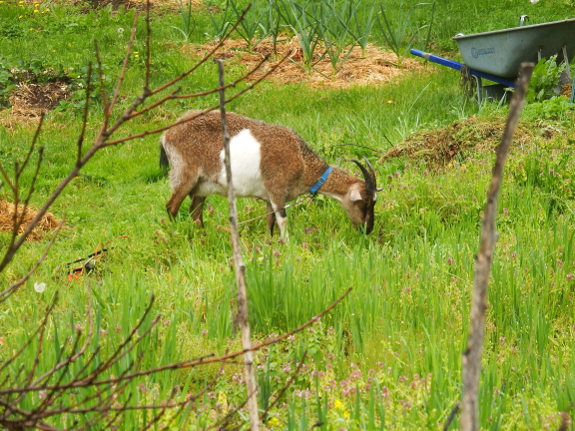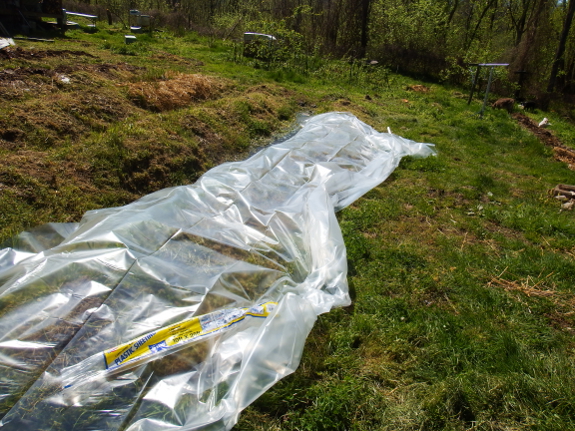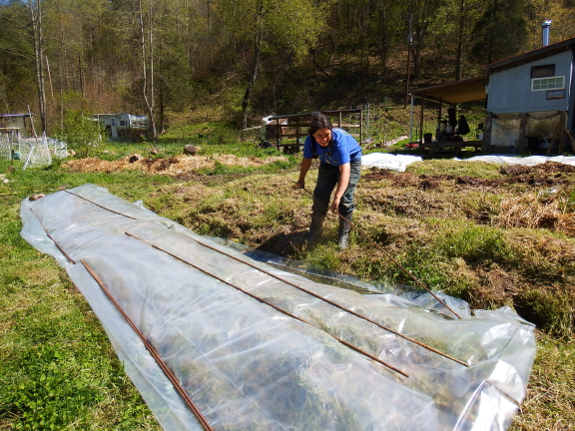
Garden solarization

Our next garden-experiment-that-I-may-live-to-regret is solarization. I'm trying all of these experiments for my upcoming soil book,
but this one was also spurred on by my fall oats cover crop not dying
as expected. I suspect the uncharacteristic overwintering ability of the
oats came about because I grazed it repeatedly in the fall, which kept
the plants at a vegetative state rather than ever getting close to
flowering. No matter why
the oats survived, I was left with a conundrum --- how to turn that
area back into plantable ground without tilling up the oats or lots of
hand weeding?

Solarization might be the
answer. The idea is that you prepare your beds (in my case by letting
Abigail eat the oats as low as she could and then begging Mark come in
with the weedwhacker to finish off the job), then you stretch a piece of
clear plastic tight over the ground to bake what's left behind.
Solarization only works during the sunny part of the year and can take
anywhere from one to three months to kill weeds and pests in the earth.
Of course, the biologist in me says --- what's to prevent solarization
from killing all of the beneficial soil microorganisms too? And, since
the plastic dropcloths often used for solarization aren't UV-stabilized,
will we end up having to pick plastic out of our soil when the
greenhouse layer disintegrates in the garden?

Mark always rolls his
eyes when I poke holes in techniques I haven't even tried, so I shrugged
and decided to give solarization a whirl. Worst-case scenario, we'll
have a biologically dead bed that I can perk back up with some
well-behaved cover crops and compost. Best-case scenario, we'll have a
bed ready to plant into in June with very little work on my part. Stay
tuned for more details as the experiment progresses!
Want more in-depth information? Browse through our books.
Or explore more posts by date or by subject.
About us: Anna Hess and Mark Hamilton spent over a decade living self-sufficiently in the mountains of Virginia before moving north to start over from scratch in the foothills of Ohio. They've experimented with permaculture, no-till gardening, trailersteading, home-based microbusinesses and much more, writing about their adventures in both blogs and books.
Want to be notified when new comments are posted on this page? Click on the RSS button after you add a comment to subscribe to the comment feed, or simply check the box beside "email replies to me" while writing your comment.

Although I haven't put clear plastic down for solarization I was always under the assumption that use of black plastic was better. I have used black plastic to attempt to kill off weeds, grass and especially that bane of my yard: Johnson grass. It does kill off the grass and weeds (Johnson grass not so much), and I found that the plastic lasts a few years (3 at the most) before it disintegrates enough to have to pick plastic pieces everywhere. Does it kill off beneficial bacteria? Well, this site says no: http://www.ipm.ucdavis.edu/PMG/PESTNOTES/pn74145.html
And apparently clear plastic is better than black plastic. Hope this helps!
Yes Anna, I hate to say it but you really need to use black. Despite the heat, things will grow well under the clear plastic. Even worse, weeds might thrive more than the cover crop.
It's also true that you don't want to use the plastic for more than a couple of years. I have a friend with a yard full of crumbles. But you can watch it & catch it before it gets that bad.
I love how "lively" the conversation is on this post and how diplomatic Anna is with her responses. We love you, Anna! It's interesting to see how passionate people are about their black plastic for killing or preventing weeds. To the black-plastic passionate supporters: yes, black plastic does absorb more heat than does clear, but did you know that dark colors actually release heat more quickly when the sun goes down than do lighter colors? (thank you physics class) Solarization is a totally sound, documented technique that Anna is using in just the right circumstance. Black plastic is useful for other purposes. And so is cardboard. And deep wood mulch. And so is chocolate, but i digress...
I recently participated in a volunteer activity (again through my college bio/ecology class) with Save the Bay in Marin County (SF area). We were helping the coordinator experiment with killing non-native invasive Harding grass with solarization very similar to what you (Anna and Mark) are doing. In the case with Save the Bay, Harding grass is wicked-difficult to kill/remove, so they were solarizing after trying hoe and to whack down as much as we could of the vegetation, then covering with hay/straw, then with the plastic. The Harding grass is very pokey, so they are hoping the hay will cushion the pokes to the plastic. They've had a hard time with other experiments with various kinds of clear plastic that do break down in UV light. This round of experimentation was with UV-protected plastic. They also started a side experiment with a piece of sort-of thin acrylic (poke-proof and hardy to UV) held down by weights. It takes at least 7 weeks to kill the vegetation. Then they plant native species.
jen g --- Thanks for posting! That kind of fascinating, firsthand information is what keeps me blogging. I was actually wondering about using those clear-plastic roofing panels, or maybe the double-plastic-with-an-air-gap greenhouse panels --- both seemed like more of a long-term choice for solarization if I like what it does with the ground. Sounds like I might be on the right track!
I was actually wondering about using those clear-plastic roofing panels, or maybe the double-plastic-with-an-air-gap greenhouse panels --- both seemed like more of a long-term choice for solarization if I like what it does with the ground. Sounds like I might be on the right track!
In the meantime, any chance you'd like to email me a photo or two Save the Bay's experiment? I'd love to add it to the book (and am always willing to plug a nice non-profit. ) My email address is anna@kitenet.net if you're interested, but don't feel obliged!
) My email address is anna@kitenet.net if you're interested, but don't feel obliged!
Nita -- Cover crops, unfortunately, haven't really made it to our region. So I'm pretty sure all the seeds I've been getting are meant for feed. (The store certainly doesn't stock any cover crop seeds that aren't also used for animal fodder.)
We do get the occasional weed seed in the oats, but it's some kind of forage turnip that doesn't cause any problems. I consider it a semi-intentional polyculture.
Great to get your oat variety recommendation! I'll try to track that one down.
In summary . . .
black works via light exclusion, similar to a kill mulch of cardboard or deep mulch.
clear works via high heat. It 'bakes' the top 6 inches of the soil. Interesting to hear about the Save the Bay use of hay/straw. I saw that mentioned somewhere else. The way it read (ensuring the hay/straw as wet), it sounded like the heat was ramped up with the process of composting. I'm wondering if a high nitrogen moisture under the clear would also help with temperature levels . . . i.e. hay/straw layer, possibly shredded to enable the plastic to be tight against it, soaked in a diluted urine solution. Just curious.
The winter kill on oats definitely has to do with their phase of growth, and I've had it go both ways. If I plant oats (whatever the feed store has) in September (zone 6b) they will get up to a foot tall or more quickly and usually winter kill in January. If I'm late getting them in until October sometime they will hold over the winter as small plants and continue growth in spring unless the winter has been particularly hard.
As for the black versus clear plastic debate, I use black plastic (generally the tarps of of lumberyard bundles which last many years) extensively as it's the only thing I've found that slows down bermuda grass. The times I tried clear plastic it acted much more like a greenhouse and took longer than the black to kill what was underneath. I'm sure this depends on the weather, so clear may work in August but not as well in April. I do not use the black plastic as a "mulch" but as a temporary covering. Right now I have it over the area where corn, sweet potatoes, and watermelons will go in this week. The oats in that area were thin and the black covering is a stop-gap to retard weed growth over the past month while waiting for summer plantings. I'll remove the plastic completely and plant.
As for your concern over soil life, I had the same. Portions of my sunniest area are infested with root knot nematodes and solarization is one of the prescribed methods of management. I was worried about the soil life, but our nematode specialist at the University of Arkansas is of the opinion that bacterial, etc., populations will rebound quickly (more quickly than the nematodes) as the effect of solarization is fairly shallow. I've decided, however, to just go with plants that don't host RKN--- sesame plants are beautiful!